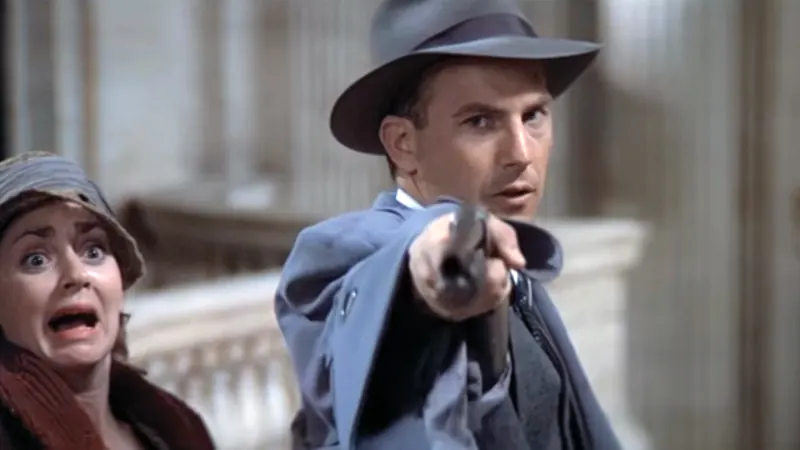Kevin Costner — Chicago Train Station Steps
Let's face it, ever since David Mamet started directing his own movies, his writing has gone downhill. His last master piece was The Untouchables (1987), which he wrote for Brian De Palma. I saw the film at the Venice Film Festival where Mamet's own House Of Games was showing. Ironically, the success of the latter might have been the nail in the coffin of Mamet's screenwriting. I believe Brian De Palma has never reached the standard of The Untouchables again, either. So let's reminisce about the good times.
UNTOUCHABLE
The Untouchables is a classic in every sense. Masterful storytelling, lush art direction, outstanding cinematography and solid performances, most of all by De Niro in his landmark role as Al Capone. Some people argue that Morricone's outdated music score ruins a contemporary viewing of the film, but I don't mind the added touch of melodrama. (De gustibus et coloribus... I also love Bowfinger) The Untouchables is textbook example of storytelling in the tradition of Aristotle, with a strong Hero's Journey framework. It shows again how powerful movies pay off on these essential story elements.
WHAT ARE YOU PREPARED TO DO?
Our movie moment follows right after the hero's lowest point, when Eliot Ness' mentor Malone is found murdered by Capone's right hand guy Frank Nitti. The scene is a screenwriting master class in designing "The Ordeal". Malone hands Ness two gifts before passing away: in the outer journey he gives Ness the time tables of the train Capone's bookkeeper will be on and for the inner journey he reminds Ness "What are you prepared to do?" The question refers to an earlier scene where Malone explained that Ness can only succeed 'the Chicago way', which is basically an upgraded version of 'an eye for an eye'. The Ordeal scene is preceded and followed by a brief shot showing Capone enjoying a night at the opera (the Shadow's high point).

THE MOMENT
You may have noticed that most mainstream movies have a scene of travel or movement at the opening of Act Three. In this healthy tradition, David Mamet wrote a train chase in the script but De Palma had splurged most of the budget by the time they had to film it, so he had to improvise.
For years De Palma had toyed with the idea of paying homage to Sergei Eistenstein's 'odessa steps' scene from Battleship Potemkin. Now the circumstances were handing it to him on a golden plate. When Ness (Costner) and Stone (Garcia) enter the train station and descend the steps, two marines cross them, going up. At this moment, every true movie buff subliminally makes the connection. Of what follows, most people will remember the spectacular Mexican standoff, but what makes this scene really work is the suspense leading up to it.
De Palma had been doing Hitchcock style exercises for over twenty years and here we see him at full maturity. The scene runs for six minutes before the first bullet is fired and another two before the standoff is fully established. A great example of a beautifully built, meaty scene with a totally satisfying climax. The purest of cinema.
Karel Segers
Karel Segers wrote his first produced screenplay at age 17. Today he is a story analyst, script editor and producer with experience in rights acquisition, script development and production. His
screenwriting classes have trained writers in Australia, Europe, Asia and the Middle East, and his clients include international award-winning filmmakers as well as three Academy Award nominees.
Karel is the founder of
The Story Department and he ranks in the world's Top 10 of most influential people for screenwriting on Twitter.